Penjada (Hung)
This work is developed in dichotomous terms and comes at the end of the “Vivace” series. It is not a purely pictorial work. First of all, it is worth noting that Miró superimposed three objects on a textured board: a piece of hemp rope and a paintbrush and a bike, both painted. Thus, in its condition of painting-object, it combines two of the artist’s favourite media: painting and sculpture.
Miró took this approach to give an idea of the levity of the remains of a bicycle. He wants to show that, even when a bike has reached the end of its useful life, it still can be reintegrated in the environment with a certain adaptive respect. This is clearly evident in the contrast between the ochre, pearly, and dark brown (rust) tones of the field behind with the bicycle’s vibrant blue, which in turn is projected on to the background. This is used to stress the suspended object’s lightness, which contrasts with the permanence conveyed by the background.
Other binomial relationships are established between the unusual vertical axis defined by the direction of the suspended bicycle and the horizontality of the dark strip at the bottom of the work; or the difference between the scale of the vast landscape hinted at in the background and the object crossing it.
Resorting to these devices produces an odd tension. Previous works showed bicycles painted on canvases, but this work departs from that approach by separating the object from the painted background, yet without renouncing to the perception of the latter. The recurring challenge of giving the painting depth is abandoned in this work for a more direct communicative approach that consists of placing the object directly over the background plane.
But this element, little more than the wreck of a bike, is no longer painted from the drawing, it is depicted with a strongly contrasted colour that hints at the ethereal and invisible. Here, one should recall that Miró sees bicycles as having connotations of visually permeable items that let one see what lies behind them.
However, an earthly link is achieved through the treatment accorded to the background. Paradoxically, this earthiness does not lie in the object but rather in what is painted. So much so that the brush itself appears buried in the inferior substrate. By contrast, what materialises in reality — the bicycle — appears to float and rise past white mountain crests reaching into a blue sky. The rope suggests the lightness and provisional nature of the object.
This piece recovers some of the Material Informalism seen in the artist’s early work. In addition, with it, Miró delves deeper into a notion of painting that is further removed from works based on drawings. Instead, he uses other forms of expression that are equally effective from a communicative perspective.
Santiago Pastor Vila
